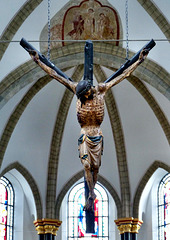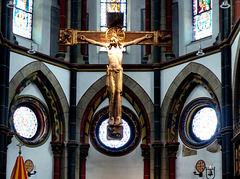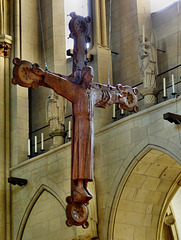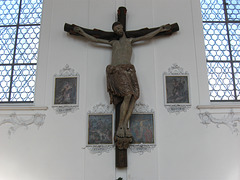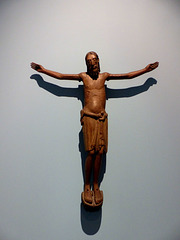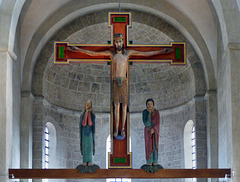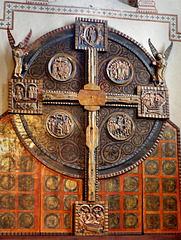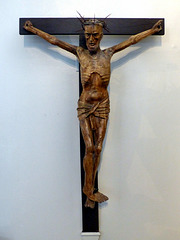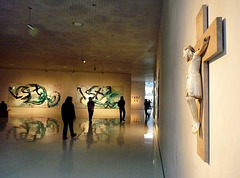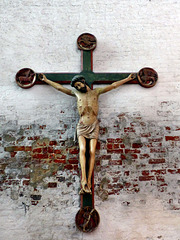
Triumphal crosses
Soest - Patrokli Cathedral
| |
|
|
Soest was one of the major cities in Westphalia during the 11th./12th century, having a population of around 10.000. Founded (like Erwitte and Paderborn to the east) on the ancient "Hellweg" (=Saltway), Soest played a major role within the Hanseatic League. Once it was even the capital of Westphalia - and (1531) a centre of Protestant Reformation in the area.
The town centre has more than 600 listed buildings and a couple of old churches. The "Patrokli Dom" was the church of the canonical foundation, which existed from the 10th century until its abolition in 1812. Since 1823 the church has been the parish church of the St. Patrokli parish.
The triumphal cross hangs down over the altar, which contains the relics of Saint Patroclus, which were transferred from Troyes to Soest in 964 by Bruno I, Archbishop of Cologne.
The cross is 2.12 m high and dates from around 1400. The images on the square ends of the cross beams on the front represent evangelists. - PiP.
Cologne - St. Severin
| |
|
|
Cologne is the fourth-largest city in Germany - and one of the oldest. A Germanic tribe, the Ubii, had a settlement here, this was named by the Romans "Oppidum Ubiorum". In 50 AD, the Romans founded "Colonia Claudia Ara Agrippinensium", the city then became the provincial capital of "Germania Inferior".
The construction of a three-aisled St. Severin basilica, replacing a Carolingian church, started in the 10th century over a Roman necropolis. At about 1230 the choir was extended over the hall crypt. The new choir got consecrated in 1237.
Around 1500 the Romanesque church got reconstructed in Gothic style.
The large crucifix (height 2.32 m) may have been here already at that time, as it is dated to the 14thj century. It is a "Crucifixus dolorosus" (aka "Y-cross"), of which the oldest one is still in the near "St. Maria im Kapitol". This type was very popular in the Rhineland areas during that time and a couple of them still exist.
Typical of the "Crucifixi dolorosi" is the body of Christ hanging on a Y-shaped tree fork with his head falling low over his chest. His sinewy arms stretch more upward than sideways, his thin body is strongly bent and deeply sunken below the breastbone, with prominently protruding ribs and a gaping wound in his side
The impression of the painted figure probably horrified the pious onlookers.
Boppard - St. Severus
| |
|
Boppard (known in Roman times as Vicus Baudobriga) lies on the Rhine Gorge, a UNESCO World Heritage Site since 2002.
After the end of the Roman Empire the population continued to live in the former Roman fort, that in the 5th century became a Merovingian royal seat. A century later a predecessor of today's St. Severus Church was built from the remains of the abandoned Roman bath. In medieval times Boppard was often visited by the German kings, who then resided in the royal court.
Excavations proofed that the early Christian church from the 6th century was a 9 × 32 meter church room with a small apse to the East. This church burnt down in the 10th century and got replaced by a smaller building. Around 1000 canons had formed a collegiate and cared for the pastoral needs.
Today´s St. Severus church was erected in the 12th and 13th centuries. The two church towers date from the middle of the 12th century (the helmets are from the 17th century), the nave was built at the beginning of the 13th century and its likely completion is dated to 1225. The choir finally dates to around the year 1234.
The triumphal cross is 285 cm high and 248 cm wide. It was masterly created around 1220/1230. Christ does not wear a crown of thorns but a royal crown that characterizes him as the victor over death.
Seen to the left is the top part of the umbraculum. The symbol is bestowed by the pope when he elevates a church to the rank of a minor basilica.
Lindau - St. Stephan
| |
|
Lindau, located near the borders to Austria and Switzerland, was mentioned first time in 882 when a nunnery was founded here. The old town is on an island, which meanwhile is connected with the mainland by a road bridge and a railway dam.
The church of St. Stephan was built around 1180, Franciscans founded a monastery here in 1224. In 1274/75 Lindau became an Imperial Free City under King Rudolf I.
Lindau became Protestant in 1528. The nunnery remained Catholic while the Franciscan monastery, from which the first Reformation preachers came, was closed. During the Thirty Years' War, Lindau was unsuccessfully besieged by Swedish troops in 1646/47. Between 1445 and 1761, 18 people were indicted in witch trials in Lindau. The last victim of the witch hunt was Maria Madlener, who was executed on August 4, 1730.
St. Stephan, founded 1180, is the largest church on the island, located next to the Catholic Münster Unserer Lieben Frau right on the marketplace. After several expansions, the church lost its Romanesque facade in 1506, but inside the building the Romanesque basilica can still be seen in the otherwise Rococo church.Since 2000 this wonderful gothic crucifix is displayed in the side aisle.
Muenster - Cathedral
| |
|
Muenster, the cultural centre of Westphalia, is a city with a population of more than 250.000 of which nearly 50.000 are students at the University of Muenster. This surely helped Muenster to gain the status of the "bicycle capital of Germany".
Charlemagne sent out St. Ludger in 792 to evangelise the area, so Ludger built a school here. When the Diocese of Muenster was founded in 805, Ludger the first bishop here. He had the first church built at this place, named "Ludgerus-Dom", that existed upto 1377, when it got demolished and replaced by a gothic cloister.
Next to the "Ludgerus Dome" a new church was built, when Dodo was bishop in Muenster 967-993. This one got the name "Ottonischer Dom". Bishop Hermann of Katzenelnbogen added a westwork to this building in 1192, that got integrated into the third chathedral built here 1225 - 1264.
This cathedral still exists, though it was a ruin after WWII and the old westwork never got rebuilt. The cathedral is a mixture of late romanesque and early gothic style.
As I have uploaded fotos taken here before, I just add some details.
The triumphal cross seen here, dates to the 13th century. The cross is 355 cm high and 262 cm wide. Here is some (German) information about the cross.
www.paulusdom.de/kunst/kunstwerke/das-triumphkreuz/
Muenster - Cathedral
| |
|
Muenster, the cultural centre of Westphalia, is a city with a population of more than 250.000 of which nearly 50.000 are students at the University of Muenster. This surely helped Muenster to gain the status of the "bicycle capital of Germany".
Charlemagne sent out St. Ludger in 792 to evangelise the area, so Ludger built a school here. When the Diocese of Muenster was founded in 805, Ludger the first bishop here.
He had the first church built at this place, named "Ludgerus-Dom", that existed upto 1377, when it got demolished and replaced by a gothic cloister. Next to the "Ludgerus Dome" a new church was built, when Dodo was bishop in Muenster 967-993. This one got the name "Ottonischer Dom". Bishop Hermann of Katzenelnbogen added a westwork to this building in 1192, that got integrated into the third chathedral built here 1225 - 1264. This cathedral still exists, though it was a ruin after WWII and the old westwork never got rebuilt. The cathedral is a mixture of late romanesque and early gothic style.
As I have uploaded fotos taken here before, I just add some details.
A detail of the triumphal cross (see previous upload). It dates to the 13th century. The cross is 355 cm high and 262 cm wide. Here is some (German) information about the cross.
www.paulusdom.de/kunst/kunstwerke/das-triumphkreuz/
Wessobrunn
Cologne - Schnütgen Museum
| |
|
Cologne is the fourth-largest city in Germany - and one of the oldest. A Germanic tribe, the Ubii, had a settlement here, this was named by the Romans "Oppidum Ubiorum". In 50 AD, the Romans founded "Colonia Claudia Ara Agrippinensium", the city then became the provincial capital of "Germania Inferior".
A city with such a history has -of course- many museums. One is the "Museum Schnütgen", devoted to medieval art. In 1906, the collection of Alexander Schnütgen, a theologian and passionate art collector, was donated to the city.
Since 1956, the museum has occupied the Romanesque church of St. Cäcilien (1130-1160), that was once part of a monastery founded in 881. An annex was added in the 1950s, but even now only about 10% of all artefacts can be displayed as of course the collection has expanded since Schnütgen´s donation.
www.museum-schnuetgen.de/Info
Cruzifix
Altenstadt - St. Michael
| |
|
This is "bigger than life". A height of 3,18m. Majestic. Well known all over Bavaria under the name "Der grosse Gott von Altenstadt" (The Great God from Altenstadt). Carved around 1215. A "Rex Gloriae". The two adjoining sculptures (Mary and John) are copies. The originals were sold to the Bavarian National Museum, where they found a new home.
Altenstadt - St. Michael
| |
|
|
This is "bigger than life". A height of 3,18m. Majestic. Well known all over Bavaria under the name "Der grosse Gott von Altenstadt" (The Great God from Altenstadt). Carved around 1215. A "Rex Gloriae". The two adjoining sculptures (Mary and John) are copies. The originals were sold to the Bavarian National Museum, where they found a new home.
Aachen - St. Folian
| |
|
|
From 936 to 1531, the Aachen chapel was the church of coronation for 30 German kings and 12 queens.
In 792 Charlemagne (aka "Charles the Great", "Karl der Grosse") began the construction of a palace here and part of the whole structure was the "Palatine Chapel". Pope Leo III consecrated the chappel in 805.
Here were the corridors of power around 800. The carolingian octogon is the middle part of the building. A gothic choir on the left was added later and so it beacem the "Aachen Cathedral". Parts of the westwork date back to the carolingian structure.
The carolingian octogon was planned by the Odo of Metz, who obviously had seen Byzantine churches.
After the erection of the Aachen Cathedral, the nobility and the canons celebrated their services in this place of worship, while the ordinary citizen had to use other churches. For this reason, a church dedicated to St. Foillan, an early Iro-Scottish missionary (brother of Saints Ultan and Fursa), was built around 1180.
After the cathedral was enlarged by an extension of the aisle in 1414, the citizens also strove for a new building of their church, which had become too small meanwhile. A three-nave Gothic building was erected and consecrated in 1482. The expansion of the cathedral brought the two buildings close together and they remained separated only by a narrow alley.
Of that church only remains of the choir, parts of the facade and a few other areas have been preserved. The remaining parts of the facade and the tower date from 1888 or are more recent. Most damages were caused by a bombing raid in 1944 when the church was almost completely destroyed.
The church got rebuilt between 1956 and 1958. This triumphal cross found its place behind bars on the outside facade.
Soest - Hohnekirche
| |
|
|
With a population of about 10.000 Soest was the most important town in Westphalia within the 11th and 12th century.
The "Soester Stadtrecht" ("Soest city law") is the oldest city law, documented in German territory. Soest was one of the most important Hanseatic cities in medieval times. During the "Soester Fehde" ("Soest Feud") it liberated itself from the Bishop of Cologne, who controlled Westphalia.
During and after the Thirty Years' War, Soest suffered a tremendous loss population and influence. At the lowest point in 1756, it had only 3,600 citizens.
Soest has still a couple of wonderful medieval, Romanesque churches, built with the regional greenish sandstone. The "Hohnekirche" (officially "St. Maria zur Höhe") is one of them. The church was built in its present form from 1180 and is one of the oldest hall churches in Westphalia. It replaced an older church here.
This giant triumph-cross is a very unique piece of art here. This "Scheibenkreuz" ("plate cross"), created ~1200, is the only one in "mainland" Europe and the oldest. Something similar can be found almost only on the island of Gotland in Sweden. However, these crosses are younger.
Here nail marks exist, so originally Christ body was nailed to the cross. The plate cross, made of spruce and pine, has a height of 3.89 m and diameter of 2.72 m.
Soest has had a very strong position within the Hanse League so there were for sure ties to Northern Europe, where this cross may have been created. A recent renovation prooved, that the wood originated in Northern Europe.
A closer look.
Soest - Hohnekirche
| |
|
With a population of about 10.000 Soest was the most important town in Westphalia within the 11th and 12th century.
The "Soester Stadtrecht" ("Soest city law") is the oldest city law, documented in German territory. Soest was one of the most important Hanseatic cities in medieval times. During the "Soester Fehde" ("Soest Feud") it liberated itself from the Bishop of Cologne, who controlled Westphalia.
During and after the Thirty Years' War, Soest suffered a tremendous loss population and influence. At the lowest point in 1756, it had only 3,600 citizens.
Soest has still a couple of wonderful medieval, Romanesque churches, built with the regional greenish sandstone. The "Hohnekirche" (officially "St. Maria zur Höhe") is one of them. The church was built in its present form from 1180 and is one of the oldest hall churches in Westphalia. It replaced an older church here.
This giant triumph-cross is a very unique piece of art here. This "Scheibenkreuz" ("plate cross"), created ~1200, is the only one in "mainland" Europe and the oldest. Something similar can be found almost only on the island of Gotland in Sweden. However, these crosses are younger.
Here nail marks exist, so originally Christ body was nailed to the cross. The plate cross, made of spruce and pine, has a height of 3.89 m and diameter of 2.72 m.
Soest has had a very strong position within the Hanse League so there were for sure ties to Northern Europe, where this cross may have been created.
Walsrode - Stadtkirche
| |
|
|
There is a legend around the foundation of the Walsrode Monastery by Count Wale. When the count had to leave his nearby castle he got stuck in the swamp with his wagon in the area of today's Walsrode. He saw this as a divine sign to buy the place and found a monastery there. He named the place "Walesrode"
The settlement that developed around the monastery was repeatedly caught up in the military conflicts from 1371 onwards. The village was helplessly exposed to the frequent looting and pillaging by the troops and was burned down by soldiers from Bremen in 1381. The citizens were allowed after that by the Saxon dukes to build fortifications. They laid out a large moat and erected four city gates.
The Reformation was very slow to take hold in the area. Duke Ernst sent the preacher Henning Kelp to Walsrode around 1528 so that the monastery would be reformed, but the resistance of the canonesses and the rural population continued for decades. It was not until 1574 that the Reformation was considered complete in the monastery of Walsrode.
The "Stadtkirche", dedicated to "St. John the Baptist" was erected in classicist style 1848 -1850. There were at least three predecessor churches, built in the 10th, 12th and 15th centuries.
The "Walsroder Kruzifix" ("Walsrode crucifix"), carved around 1500 from the studio of the artist Hans Brüggemann, who was born around 1480 in Walsrode. It is known especially for the "Bordesholm Altar", now in the Schleswig Cathedral.
Cologne - KOLUMBA
| |
|
KOLUMBA is the art museum of the Archdiocese of Cologne, originally founded in 1853. During WWII the museum´s collection got evacuated and was saved. Upto 2007 the museum was located near the cathedral. The site of the muesum´s new home was occupied by the Church of St. Columba, which was destroyed in WWII. The new award winning structure designed by Swiss architect Peter Zumthor, built for the museum now shares its site with the ruins of the Gothic church.
The museum is known for very interesting exhibitions, that are altered several times over the year displaying the own collection in changing contexts.
www.kolumba.de/?language=eng
Cologne - KOLUMBA
| |
|
KOLUMBA is the art museum of the Archdiocese of Cologne, originally founded in 1853. During WWII the museum´s collection got evacuated and was saved. Upto 2007 the museum was located near the cathedral. The site of the muesum´s new home was occupied by the Church of St. Columba, which was destroyed in WWII. The new award winning structure designed by Swiss architect Peter Zumthor, built for the museum now shares its site with the ruins of the Gothic church.
The museum is known for very interesting exhibitions, that are altered several times over the year displaying the own collection in changing contexts.
www.kolumba.de/?language=eng
Cologne - KOLUMBA
| |
|
KOLUMBA is the art museum of the Archdiocese of Cologne, originally founded in 1853. During WWII the museum´s collection got evacuated and was saved. Upto 2007 the museum was located near the cathedral. The site of the muesum´s new home was occupied by the Church of St. Columba, which was destroyed in WWII. The new award winning structure designed by Swiss architect Peter Zumthor, built for the museum now shares its site with the ruins of the Gothic church.
The museum is known for very interesting exhibitions, that are altered several times over the year displaying the own collection in changing contexts.
12th century ivory crucifix (detail) - (see prev. upload)
www.kolumba.de/?language=eng
Lübeck - St. Marien
| |
|
The area around Lübeck, today a large city with a population of more than 200,000, had been settled by Slavs since the 7th century. Slavs had a settlement north of the present city called "Liubice", which was razed by the pagan Rani tribe in 1128.
15 years later Adolf II, Count of Schauenburg and Holstein, founded the modern town as a German settlement on the river island of Bucu. He built a new castle, first mentioned as existing in 1147. Adolf II had to cede the castle to the Duke of Saxony, Henry the Lion, in 1158. After Henry's fall from power in 1181, the town became an Imperial city. Emperor Barbarossa ordained that the city should have a ruling council of 20 members. With the council dominated by merchants, trade interests shaped Lübeck's politics for centuries.
In the 14th century, Lübeck became the "Queen of the Hanseatic League", being by far the largest and most powerful member of that medieval trade organization. In 1375, Emperor Charles IV named Lübeck one of the five "Glories of the Empire", a title shared with Venice, Rome, Pisa, and Florence.
Conflicts about trading privileges resulted in fighting between Lübeck (with the Hanseatic League) and Denmark and Norway – with varying outcome. While Lübeck and the Hanseatic League prevailed in conflicts in 1435 and 1512, Lübeck lost when it became involved in a civil war that raged in Denmark from 1534 to 1536. From then on Lübeck's power slowly declined. The city remained neutral in the Thirty Years' War, but the devastation from the decades-long war and the new transatlantic orientation of European trade caused the Hanseatic League – and thus Lübeck with it – to decline in importance. However, Lübeck still remained an important trading town on the Baltic Sea.
In 1160 Henry the Lion moved the bishopric of Oldenburg to Lübeck and endowed a cathedral chapter. In 1163 a wooden church was built, however, at the beginning of the 13th century, it was no longer sufficient to meet the representative demands of the self-confident burghers.
St. Marien was built between 1250 and 1350. It has always been a symbol of the power and prosperity of the old Hanseatic city. It situated at the highest point of the island that forms the old town.
Gothic cathedrals in France and Flanders made of natural stone were the models for the new construction of Lübeck's three-nave basilica.
St. Marien epitomizes North German "Brick Gothic" and set the standard for many churches in the Baltic region. The church embodied the towering style of Gothic architecture using brick.
The incentive for the City Council to undertake such an enormous project was rooted in the bitter dispute with the Lübeck bishopric. As a symbol of the long-distance merchants' desire for freedom and the secular power of the city, which had been free of the Empire since 1226, the church building in the immediate vicinity of Lübeck's city hall and the market square was intended to clearly and uncatchably surpass in size the city's bishop's church, Lübeck Cathedral.
In March 1942, St. Marien (as well as the Cathedral and St. Peter) was almost completely burned out during the air raid on Lübeck, which destroyed one-fifth of the city centre. Reconstruction of the church began in 1947 and was essentially completed.
Jump to top
RSS feed- Latest items - Subscribe to the latest items added to this album
- ipernity © 2007-2024
- Help & Contact
|
Club news
|
About ipernity
|
History |
ipernity Club & Prices |
Guide of good conduct
Donate | Group guidelines | Privacy policy | Terms of use | Statutes | In memoria -
Facebook
Twitter


